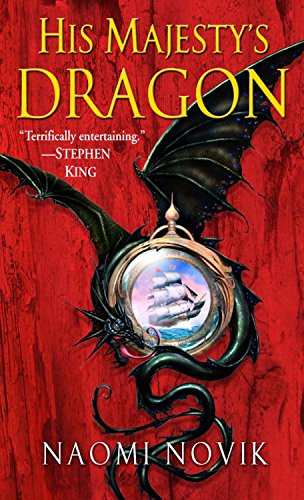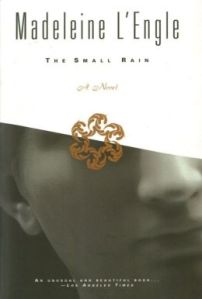
Title: His Majesty’s Dragon (the Temeraire series)
Author: Naomi Novik
Publisher: Del Rey (Random House)
ISBN: 9780345481283
Alethea’s Review (at age 19):
Carver, very pale, stepped towards the creature, holding out his hand, which trembled visibly. “Good dragon,” he said; the words sounded rather like a question. “Nice dragon.”
Will Laurence is perfectly happy with his life as a navy captain. He gets to battle Napoleon’s forces with a crew he loves (and stay far away from his estranged father). But when he seizes a rare dragon egg which hatches before he has the chance to foist it off on someone qualified, Laurence and his dragon Temeraire are flung headlong into the chaotic Aerial Corps, where women can be captains, no one addresses him as “sir,” and his vehicle talks back.
The Temeraire series was recommended to me as a light summer read. It is not a light summer read. But Novik’s alternate history of the Napoleonic Wars is a lot of fun nevertheless. Temeraire the dragon is a charming character: smart, unconventional, and a perfect companion for proper, buttoned-down Laurence, who finds his views challenged more and more as the series continues. Although it’s not a comedic book in the truest sense of the word, Novik has perfected the occasional wry humour that makes you twist one corner of your mouth up instead of laughing out loud. His Majesty’s Dragon is written like an old-timey novel, with long sentences, ample semicolons and older words thrown into the mix (“cessation of hostilities,” anyone?). This makes it more convincing as a period novel but also a little difficult to read. The plot meanders sometimes (not only in this book but in the next ones), but you don’t really notice that until you’ve finished the novel, so I don’t think it’s a big deal that sometimes a tangent pops up quietly in the corner. (If you find yourself forgetting what’s happened in previous books, I recommend these Temeraire Rereads.)
I want to mention especially that in this time period, racism and sexism are alive and well, to the point where female captains are hidden from the public and slaves are still being kidnapped and sold. I wouldn’t recommend this book for younger teens because of how deep these prejudices run in 19th century England. Laurence has internalized a lot of these views, to the point of being shocked that young women could be part of the Corps, and it comes across in the narration. It may be difficult for a younger reader to understand that these views should not be internalized or condoned, especially when the protagonist espouses some of them (Laurence and Temeraire are abolitionists, but one of Laurence’s friends is not). Later novels deal more strongly with the slave trade and Temeraire’s battle to gain rights for dragons, and we spend more time with cool female captains like Roland and Harcourt, but the first book is mostly about fighting and therefore glosses over some of these issues.
Here is where I admit that His Majesty’s Dragon is actually not my favourite book of the series. Novik doesn’t really deal with heavier subject matter until Throne of Jade (#2), so the first one comes across as fluffier than the rest of the series. Also, we don’t get diverse recurring characters until Black Powder War (#3), and even then we only really get one. Personally I’m partial to Empire of Ivory (#4), but that might just be because #3 is depressing and I spent the whole of #2 worrying that Novik would be super racist towards Chinese people (she wasn’t, so I worried in vain).
While I’m admitting things, I might as well mention that Laurence is not my favourite ever protagonist, either. He’s a classically stoic, proper English gentleman, which makes sense for the time period (as he’s allowed to go places and be involved in decision-making where a woman or a person of colour wouldn’t). But he’s a bit boring, frankly, when compared to firebrands like bold, straight-talking Captain Jane Roland, or even his dragon Temeraire. His agony over improper behaviour, although it eases after the first book, still affords him many sleepless nights (which gets tedious after a while, when we all know what he ought to do but he’s worried about what society might think). Despite that, the other characters more than make up for it, and Laurence is always just endearing enough for me to forgive him his priggishness.
But let’s be honest here: I’d forgive the Temeraire series a lot because of how cool the premise is. I mean, warrior dragons? Setting up your rifles on dragonback to fire volleys at the enemy crew? Acid-spitters who only let women captain them? Yeah, my gripes are pretty minor. Give it a shot if you like historical fiction, fantasy, alternate history or even just dragons.
Warning (books 1-5 because I haven’t read 6-8 yet): Slavery and brutality towards slaves, war and violence, anti-black racism and sexism, one mention of rape (under the euphemism “outraged”), occasional swearing (f*ck, etc.), occasional mentions of sex (and mating of dragons), illegitimate children.






